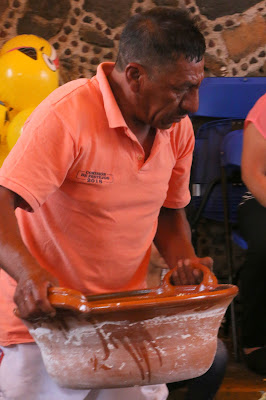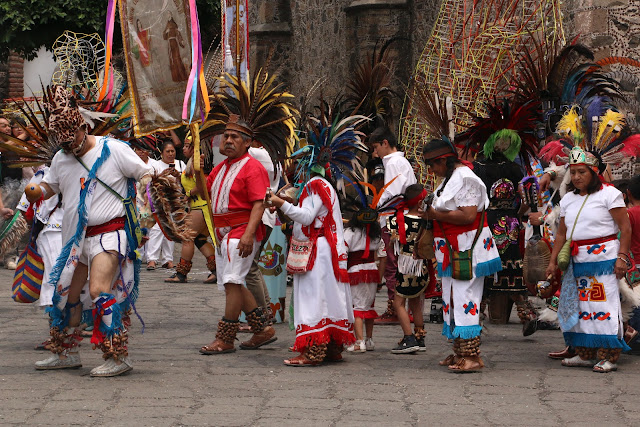History of Pueblo San Pedro Mártir de Verona Texopalco
San Pedro Mártir is one of a line of original pueblos in the north-central part of what is now Delegación/Alcaldía Tlalpan. The line begins with the current Tlalpan Centro and runs south to the base of the Sierra Chichinautzin volcanic mountain range. In indigenous times, these pueblos lay along the footpath that led up over the mountains and onward to Cuernavaca in what is now the state of Morelos and on through the present-day state of Guerrero to the Pacific Coast. That path is now the expressway 95D that goes to Acapulco.
With this visit to San Pedro Mártir, we will have been to all but one of the sequence of those at the base of the mountains. There are others above, on the eastern slope of towering Mt. Ajusco, such as Santa María Magdalena Petlacalco. (For a description of the dramatically contrasting geography of the north and south of Delegación Tlalpan, see our post on Santa María Magdalena Petlacalco.)
 |
| Original pueblos of north-central Tlalpan Tlalpan Centro (Villa San Agustín de las Cuevas, transformed by the Spanish into a formal Spanish village, green/purple star); Santa Úrsula Xitla (navy blue/green star); Chimalcoyotl (or Chimalcoyoc, dark orange/light orange star); San Pedro Mártir (green/yellow star). South of San Pedro is San Andrés Totoltepec, which we hope to visit one of these days. |
San Pedro´s indigenous name was Texopalco (Tesh-o-PAHL-co, apparently meaning "painted blue" in Nahuatl). It was likely founded sometime in the 13th or 14th centuries C.E. by the Nahuatl-speaking Tepaneca, as part of their altepetl (city-state) along the west side of Lake Texcoco, ruled from their central city of Azcapotzalco on the southwest shore of the lake. Like the rest of the Valley of Mexico, it came under Mexica/Azteca control in the early 15th century. Its indigenous name has dropped from usage in contemporary times.
Fiesta of San Pedro de Verona Mártir
San Pedro, St. Peter of Verona Mártir was a Dominican monk who lived from 1205 to 1252. In 1221, he joined the Order of Preachers, commonly known as the Dominicans from the name of its founder, Domingo de Guzman, who founded the order in 1215 and died the same year that Pedro joined it. Pedro's parents were members of a Gnostic sect called Cathars, popular in southern France and northern Italy in the 12th and early 13th century. The Cathars believed in two supreme gods — one of good and one of evil — and were held to be heretics by the monotheistic Roman Catholic Church. The Dominicans preached to try to convert them to orthodox Roman Catholicism. Pedro was assassinated by a Cathar believer in April, 1252. Hence, his feast day in April.
So on Sunday, April 28, we travel by taxi to the pueblo that has born his name for nearly five hundred years, San Pedro Mártir, to witness its patron saint fiesta.
 |
| Atrio (atrium) and Chapel of San Pedro de Verona Mártir. The motto is "Long live San Pedro Mártir" (i.e., the saint and his pueblo). The portada is made of fresh mums. The walls of both the atrio and chapel are built of sturdy tezontle, volcanic rock. The chapel was built in the 17th century by Dominicans, likely as a visita, without a resident monk but visited by monks headquartered in San Agustín de las Cuevas (Tlalpan Centro) There is no plaza in front, just a narrow barrio street. |
The Original Chapel
 |
| Chapel of San Pedro de Verona Mártir The fiesta portada is made of fresh mums. The motto is "Resurrection and Life". |
Entering the small chapel, we are immediately struck by two aspects of its architecture: Its simplicity, strongly accented with tezontle arches and doorways, and an amazingly colorful tile floor and lower walls. We have not seen anything like it among the many early colonial churches we have visited.
 |
| Sanctuary of San Pedro Mártir |
  |
| Pillars and doorways of tezontle. |
The Modern Church
To the left of the original chapel is a dramatically contrasting modern church.
 |
| Sanctuary |
 |
| San Pedro de Verona Mártir, surrounded by flowers typical of a patron saint fiesta. "Enlighten me, Lord," says the arch above the saint. |
The Fiesta Gets Underway
Part One: Concheros
As we finish exploring the physical setting of the chapel, church and open-air stage, we hear coming from outside the atrio the plaintive, eerie call of a concha (conch shell) trumpet, an ancient, indigenous instrument used to summon people and initiate rituals. So we hurry across the atrio to the entrance.
 |
| Two conchas are sounded by an arriving comparsa (troupe) of concheros, indigenous dancers we have seen many times at fiestas. See our post: Traditional Indigenous Dancers: Concheros and Danzantes Aztecas |
 |
| An Aztec warrior carries a sacred bundle containing a statue of Quetzalcoatl, the Plumed Serpent god. Via the concheros, indigenous gods are incorporated into Christian worship. |
 |
| Conchero tuning his concho in preparation for the dance. |



Part Two: Arrival of the Neighboring Pueblos
 |
| Banners of San Lorenzo Huipulco in Tlalpan, Guadalupe de Huitzilac from over the mountains in the State of Morelos. |
 |
| San Tomás Apostol Ajusco and other pueblos on the high slopes of Mt. Ajusco in central Tlalpan. The second banner honors San Miguel Archangel and the third la Virgen de Guadalupe, but we are unable to identify their pueblos of origin. |
  |
| Neighboring Santa Úrsula Xitla, which we recently visited, and Chimalcoyoc (Chimalcoyotl) which we have also visited. |
 |
| The visiting pueblos, with their banners, enter the outdoor service. They are given seats of honor in front. |
 |
| The welcoming congregation. |
 |
| Banners of all the visiting pueblos line the side wall. |
 |
| Gifts and saints are brought by some. The basket at left contains wafers to be used as the Host in Communion. The saint is St. Francis, in demandita, "little petition", portable form. |
 |
| Pueblo Huitzilac, in Morelos, brings a basket of fruit. |
Part Three: Mass Begins
 |
| The priests enter; an auxiliary bishop, from the Diocese of Mexico City, will officiate. That is quite an honor for the pueblo |
 |
| All is ready for the Mass to begin. |
 |
| Parishioners |

Part Four: Santiagueros, Warriors of St. James and the Battle Against the Moors
Meanwhile, turning our attention back to the atrio, we find that a comparsa of Santiagueros, Warriors of St. James, have arrived. We have seen them before at other fiestas. They will dramatize the conflict of the Christian Spanish against the Muslim Moors, who invaded the Iberian Peninsula in the 8th century, in order to drive them from the peninsula back to North Africa and claim the land for the various Christian principalities that were to come to form the nation of Spain in the late 15th century.
 |
| A Christian Spanish soldier and a Muslim Moor prepare to do battle. |
 |
| Each side lines up against the other. Curiously, a Spaniard leads the Moors. In a previous encounter with the Santiagueros, we asked one of the players about this. He said that many Spaniards, such as the famous el Cid, fought on the side of the Moors. The conflict was as much about power over territory and its wealth as about religion. For a fuller description of the drama, see our post: Drama of the Christians vs the Pagans at Santa Maria Tepepan |

 |
| Always, children are actively included in the various comparsas; the tradition is thus handed down so as to be carried on. |
 |
| These Santiagueros are accompanied only by a drummer. Some also include a wooden flute. |
Part Five: Chinelos Jump and Spin
Following the Santiagueros' battle, a comparsa of chinelos (disguised ones in Nahuatl) move into the center of the atrio and begin their dervish-like dance of jumping and spinning.
 |
| These chinelos are from San Pedro Mártir, as displayed on the back of one of their costumes. |
 |
| Again, children are major participants. What kid wouldn´t like to dress in disguise and jump and spin before an audience? |
 |
| The littlest chinelo. |
Part Six: The Concheros Dance
While the chinelos are dancing, the concheros enter the new sanctuary to venerate San Pedro and pray for his blessing.
 |
| The woman in front, far right, holds a traditional censer containing copal, a resin burned by the indigenous people as incense. |
 |
| They play and sing various hymns. |


Part Seven: Mariachis and Arrieros, Mule Drivers
 |
| Mariachi band, with an altar to San Pedro in front. |
They are playing for yet another comparsa, or more accurately in this case, a cuadrilla of arrieros, a team of mule drivers. We recently had our first encounter with such a group in our visit to nearby Santa Úrsula Xitle. We learned of the importance of mule drivers in this area at the base of the Sierra Chichinautzin during Colonial times. Up until motorized vehicles were invented in the early 20th century, they were responsible for transporting goods that arrived via the Manila galleons from the Philippines to the port in Acapulco on to Mexico City. Other arrieros then transported them to Veracruz, on the coast of the Gulf of Mexico, for shipment to Spain.
 |
| However, something more than a dance seems to be going on. The man, far left in the orange shirt, seems occupied with building a fire. A large steel cauldron sits nearby. |
  |
| He cleans a cazuela, casserole bowl. |
 |
| We ask another onlooker what is happening. He explains that the man is preparing atole, a corn-base drink, and other foods to be served to the community. |
The Fiesta That Has It All
The streets adjoining the atrio are filled with the juegos (who-EH-gos) mecánicos, the fair rides that typically are part of a fiesta. While they will be filled with riders in the evening, they are starting to have young customers.
And there has been, as always for us, el pueblo, the people:
It is time for us to go. It has been quite a day, quite a fiesta. We have seen four dance groups, all the types we have seen in this southern part of the city:
- Concheros;
- Santiagueros;
- Chinelos and
- Arrieros (in just our second encounter of them).
We have never been at a fiesta where all four participated. It has been a fiesta that has it all. Needless to say, a good time was had by all, including this güero extranjero (pale-skinned foreigner).
 |
| Tlalpan (mustard yellow), by far the largest delegación/alcaldía, takes up most of the southwest of Mexico City |























No comments:
Post a Comment